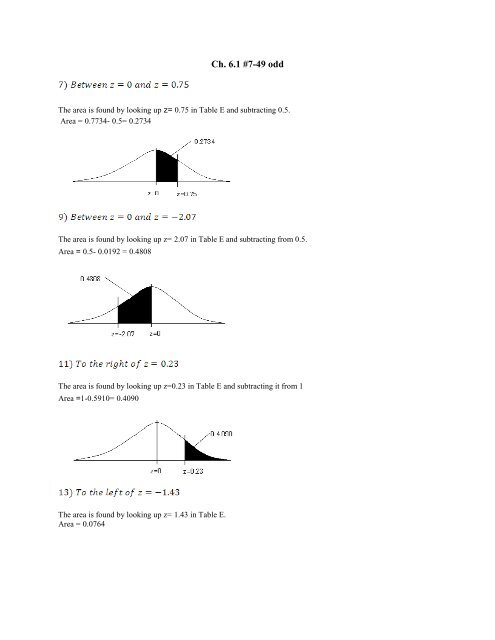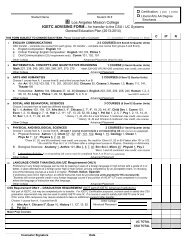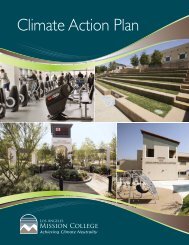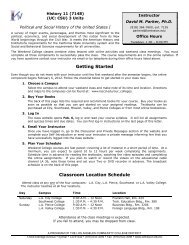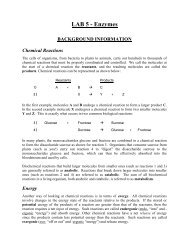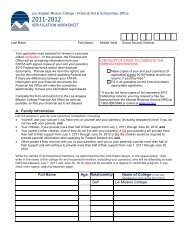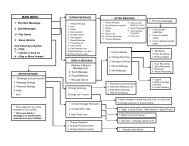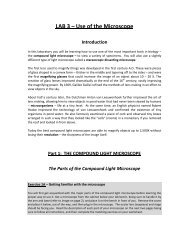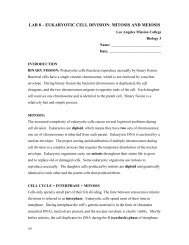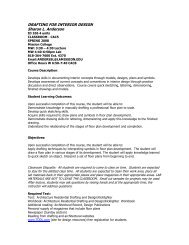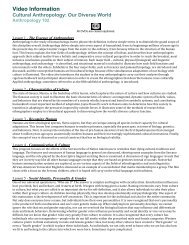Ch. 6.1 #7-49 odd
Ch. 6.1 #7-49 odd
Ch. 6.1 #7-49 odd
Create successful ePaper yourself
Turn your PDF publications into a flip-book with our unique Google optimized e-Paper software.
<strong>Ch</strong>. <strong>6.1</strong> <strong>#7</strong>-<strong>49</strong> <strong>odd</strong><br />
The area is found by looking up z= 0.75 in Table E and subtracting 0.5.<br />
Area = 0.7734- 0.5= 0.2734<br />
The area is found by looking up z= 2.07 in Table E and subtracting from 0.5.<br />
Area = 0.5- 0.0192 = 0.4808<br />
The area is found by looking up z=0.23 in Table E and subtracting it from 1<br />
Area =1-0.5910= 0.4090<br />
The area is found by looking up z= 1.43 in Table E.<br />
Area = 0.0764
15) Between z = 1.05 and z= 1.78<br />
The area is found by looking up the values 1.05 and 1.78 in Table E and subtracting the areas.<br />
Area= 0.9625– 0.8531 = 0.1094.<br />
0.1094<br />
Z=1.78<br />
Z=1.05<br />
58<br />
The area is found by looking up the values z=1.56 and z=1.83 in Table E and subtracting the areas.<br />
Area = 0.0594 - 0.0336 = 0.0258<br />
19) Between z = -1.53 and z= - 2.08<br />
The area is found by looking up the values z=1.53 and z= 2.08 in Table E and subtracting the areas.<br />
Area = 0.0630- 0.0188 = 0.0442<br />
.
The area is found by looking up z= 2.11 in Table E.<br />
Area = 0.9826<br />
23) To the right of z=-0.25<br />
The area is found by looking up z= 0.25 in Table E and subtracting it from 1.<br />
Area= 1- 0.4013 = 0.5987<br />
For z = -0.44, the area is 0.3300. For z = 1.92, the area is 1 - 0.9726 = 0.0274<br />
Area = 0.3300 + 0.0274 = 0.3574<br />
Area = 0.7486 - 0.5 = 0.2486
Area = 0.5 - 0.0582 = 0.4418<br />
Area =1 - 0.9977 = 0.0023<br />
Area = 0.1131
Area= 0.9591 - 0.0069 = 0.9522<br />
Area =0.9985 - 0.9279 = 0.0706<br />
Area = 0.9222<br />
For exercises 40 through 45, find the z value that corresponds to the given area.<br />
41)
Since the z score is on the left side of 0, use the negative z table. Areas in the negative z<br />
table are in the tail, so we will use 0.5 - 0.4175 = 0.0825 as the area. The closest z score corresponding to an area of<br />
0.0825 is z=- 1.39.<br />
43)<br />
Z=- 2.08, found by using the negative z table.<br />
45)<br />
Use the negative z table and 1 - 0.8962 = 0.1038 for the area. The z score is z= -1.26.<br />
47) Find the z values to the left of the mean so that<br />
a) 98.87% of the area under the distribution curve lies to the right of it.<br />
Using the negative z table, area = 1 - 0.9887 = 0.0113. Hence Z=- 2.28.<br />
b) 82.12% of the area under the distribution curve lies to the right of it.<br />
Using the negative z table, area = 1 – 0.8212 = 0.1788. Hence Z=- 0.92.
c) 60.64% of the area under the distribution curve lies to the right of it.<br />
Using the negative z table, area = 1 – 0.6064 = 0.3936. Hence Z=- 0.27.<br />
<strong>49</strong>) Find two z values, one positive and one negative, so that the areas in the two tails total the<br />
following values.<br />
a) 5%<br />
For total area = 0.05, there will be area = 0.025 in each tail. The z scores are 1.96.<br />
b) 10%<br />
For total area =0.10, there will be area = 0.05 in each tail. The z scores are 1.645.
c) 1%<br />
For total area = 0.01, there will be area = 0.005 in each tail. The z scores are z= 2.58.<br />
Section 6-2 # 1, 2, 9, 11, 15, 21, 22, 23, 26, 28, 30<br />
1. Admission <strong>Ch</strong>arges for Movies The average admission charge for a movie is $5.81. If the<br />
distribution of movie admission charges is approximately normal with a standard deviation of $0.81, what<br />
is the probability that a randomly selected admission charge is less than $3.50?<br />
X <br />
$3.50 $5.81<br />
z 2.85<br />
$0.81<br />
then look up z = -2.85 in Table E and you get that the area = 0.0022 or 0.22%<br />
Pz ( 2.85) 0.0022 or 0.22%<br />
-2.85 0<br />
2. Teachers’ Salaries The average annual salary for all U.S. teachers is $47,750. Assume that the<br />
distribution is normal and the standard deviation is $5680. Find the probability that a randomly selected<br />
teacher earns<br />
a. Between $35,000 and $45,000 a year<br />
X <br />
35,000 47,750<br />
z 2.24<br />
5680<br />
45,000 47,750<br />
z <br />
0.48<br />
5680<br />
P( 2.24 z 0.62) 0.3156 0.0125 0.3031 or 30.31%
. More than $40,000 a year<br />
X <br />
40,000 47,750<br />
z 1.36<br />
5680<br />
Pz ( 1.36) 1 0.0869 0.9131 or 91.31%<br />
c. If you were applying for a teaching position and were offered $31,000 a year, how would you feel<br />
(based on this information)?<br />
Not too happy! It's really at the bottom of the heap!<br />
X <br />
31,000 47,750<br />
z 2.95<br />
5680<br />
Pz ( 2.95) 0.0016<br />
Only 0.16% of salaries are below $31,000.<br />
9. Miles Driven Annually The mean number of miles driven per vehicle annually in the United States is<br />
12,<strong>49</strong>4 miles. <strong>Ch</strong>oose a randomly selected vehicle, and assume the annual mileage is normally distributed<br />
with a standard deviation of 1290 miles. What is the probability that the vehicle was driven more than<br />
15,000 miles? Less than 8000 miles? Would you buy a vehicle if you had been told that it had been driven<br />
less than 6000 miles in the past year?<br />
X <br />
15,000 12,<strong>49</strong>4<br />
For x15,000 miles : z 1.94<br />
1290<br />
Pz ( 1.94) 1 0.9738 0.0262<br />
X <br />
8,000 12,<strong>49</strong>4<br />
For x 8,000 miles : z 3.48<br />
1290<br />
Pz ( 3.48) 0.0003<br />
X <br />
6,000 12,<strong>49</strong>4<br />
For x 6,000 miles : z 5.03<br />
1290<br />
Pz ( 5.03) 0.0001<br />
Maybe it would be good to know why it had only been driven less than 6000<br />
miles.<br />
11. Credit Card Debt The average credit card debt for college seniors is $3262. If the debt is normally<br />
distributed with a standard deviation of $1100, find these probabilities.
a) That the senior owes at least $1000<br />
X 1000 3262 2262<br />
z 2.06<br />
1100 1100<br />
Pz ( 2.06) 1 0.0197 0.9803 or98.03%<br />
-2.06 0<br />
b) That the senior owes more than $4000<br />
X <br />
4000 3262 738<br />
z 0.67<br />
1100 1100<br />
Pz ( 0.67) 1 0.7486 0.2514 or 25.14%<br />
0 0.67<br />
c) That the senior owes between $3000 and $4000<br />
X 3000 3262 262<br />
z 0.24<br />
1100 1100<br />
X <br />
4000 3262 738<br />
z 0.67<br />
1100 1100<br />
P( 0.24 z 0.67) 0.7486 0.4052 0.3434 or 34.34%<br />
-0.24 0.67
15. Waiting to Be Seated The average waiting time to be seated for dinner at a popular restaurant is<br />
23.5 minutes, with a standard deviation of 3.6 minutes. Assume the variable is normally distributed.<br />
When a patron arrives at the restaurant for dinner, find the probability that the patron will have to wait the<br />
following time.<br />
a) Between 15 and 22 minutes<br />
X 15 23.5 8.5<br />
z 2.36<br />
3.6 3.6<br />
X 22 23.5 1.5<br />
z 0.42<br />
3.6 3.6<br />
P( 2.36 z 0.42) 0.3372 0.0091 0.3281<br />
-2.36 -0.42<br />
b) Less than 18 minutes or more than 25 minutes<br />
X 18 23.5 5.5<br />
z 1.53<br />
3.6 3.6<br />
X <br />
25 23.5 1.5<br />
z 0.42<br />
3.6 3.6<br />
P( z 1.53 or z 0.42) 0.0630 (1 0.6628) 0.063 0.3372 0.4002<br />
-1.53 0.42<br />
c) Is it likely that a person will be seated in less than 15 minutes?<br />
X 15 23.5 8.5<br />
z 2.36<br />
3.6 3.6<br />
Pz ( 2.36) 0.0091
Since the probability is small, it is not likely that a person would be seated in less than 15 minutes.<br />
21. Cost of Personal Computers The average price of a personal computer (PC) is $9<strong>49</strong>. If the<br />
computer prices are approximately normally distributed and $100 , what is the probability that a<br />
randomly selected PC costs more than $1200? The least expensive 10% of personal computers cost less<br />
than what amount?<br />
Let X be the amount a least expensive personal computer can cost.<br />
X <br />
1200 9<strong>49</strong> 251<br />
z 2.51<br />
100 100<br />
Pz ( 2.51) 1 0.9940 0.006 or 0.06%<br />
2.51<br />
For the least expensive 10%, the corresponding z-value is z = - 1.28.<br />
x 9<strong>49</strong><br />
1.28<br />
<br />
100<br />
x 1.28(100) 9<strong>49</strong> $821<br />
Area is .10<br />
Z= -1.28<br />
22. Reading Improvement Program To help students improve their reading, a school district decides<br />
to implement a reading program. It is to be administered to the bottom 5% of the students in the district,<br />
based on the scores on a reading achievement exam. If the average score for the students in the district is<br />
122.6, find the cutoff score that will make a student eligible for the program. The standard deviation is 18.<br />
Assume the variable is normally distributed.<br />
122.6, 18<br />
The bottom 5% (area) is in the left tail of the normal curve. The corresponding z score is found using area = 0.05.<br />
Thus, z= -1.645.<br />
x z<br />
<br />
x 1.64518 122.6 92.99 or 93
Therefore, a cutoff score of 93 will make a student eligible for the program.<br />
23. Used Car Prices an automobile dealer finds that the average price of a previously owned vehicle is<br />
$8256. He decides to sell cars that will appeal to the middle 60% of the market in terms of price. Find the<br />
maximum and minimum prices of the cars the dealer will sell. The standard deviation is $1150, and the<br />
variable is normally distributed.<br />
$8256, $1150 . The middle 60% means that 30% of the area will be on either side of the mean.<br />
The corresponding z score is found using area = 0.20.<br />
The z scores are 0.84.<br />
Min z * 0.84*1150 8256 $7290<br />
Max z * 0.84*1150 8256 $9222<br />
26. High School Competency Test a mandatory competency test for high school sophomores has a<br />
normal distribution with a mean of 400 and a standard deviation of 100.<br />
a) The top 3% of students receive $500. What is the minimum score you would need to receive this<br />
award?<br />
400, 100<br />
10.03 0.97<br />
z 1.88<br />
Min z * 1.88*100 400 588<br />
588 is minimum score to receive the award.<br />
b) The bottom 1.5% of students must go to summer school. What is the minimum score you would need<br />
to stay out of this group?<br />
400, 100<br />
For the bottom 1.5%, the area is 0.015.<br />
z 2.17<br />
Min z * 2.17*100 400 183<br />
183 is the minimum score to avoid summer school.
28. Bottled Drinking Water Americans drank an average of 23.2 gallons of bottled water per capita in<br />
2004. If the standard deviation is 2.7 gallons and the variable is normally distributed, find the probability<br />
that a randomly selected American drank more than 25 gallons of bottled water. What is the probability<br />
that the selected person drank between 18 and 26 gallons?<br />
23.2, 2.7<br />
For x 25 gallons:<br />
25 23.2<br />
z 0.67; the corresponding area=0.7486<br />
2.7<br />
Pz ( 0.67) 1 0.7486 0.2514<br />
0.67<br />
For 18 x 26gallons:<br />
18 23.2<br />
z 1.93; the corresponding area=0.0268<br />
2.7<br />
26 23.2<br />
z 1.04; the corresponding area=0.8508<br />
2.7<br />
P(18 x1.04) 0.8508 0.0268 = 0.824<br />
-1.93 1.04<br />
30. Security Officer Stress Tolerance to qualify for security officers’ training, recruits is tested for<br />
stress tolerance. The scores are normally distributed, with a mean of 62 and a standard deviation of 8. If<br />
only the top 15% of recruits are selected, find the cutoff score.<br />
62, 8<br />
10.15 0.85<br />
The corresponding z score is 1.04<br />
Cutoff z <br />
1.048 62 70.32<br />
6.3 #9, 13, 15, 17, 21, 23<br />
9. College Costs The mean undergraduate cost for tuition, fees, room, and board for four-year<br />
institutions was $26,489 for the 2004–2005 academic year. Suppose that σ =$3204 and that 36 four-year<br />
institutions are randomly selected. Find the probability that the sample mean cost for these 36 schools is<br />
a. Less than $25,000<br />
µ=26,489, n=36, σ= 3204, P( x < 25.000)
x x 25,000 26,489<br />
Z <br />
2.79<br />
3204<br />
n 36<br />
P( z < -2.79)=0.0026<br />
-2.97<br />
b. Greater than $26,000<br />
µ=26,489, n=36, σ= 3204, P( x >26.000)<br />
Z <br />
x <br />
<br />
<br />
x 26,000 26,489<br />
0.92<br />
3204<br />
n 36<br />
-0.92<br />
P( z > -0.92)=1-0.1788 = 0.8212<br />
c. Between $24,000 and $26,000.<br />
µ=26,489, n=36, σ= 3204, P($24,000 < x
x x<br />
Z <br />
<br />
x<br />
x 20 21<br />
1.72<br />
2.9<br />
n 25<br />
P(z
Pz ( 0.90) 1 0.8159 0.1841 18.41%<br />
c) Why is the probability for part a greater than that for part b?<br />
Because the individual values are more variable than means.<br />
17. Water Use The Old Farmer’s Almanac reports that the average person uses 123 gallons of water<br />
daily. If the standard deviation is 21 gallons, find the probability that the mean of a randomly selected<br />
sample of 15 people will be between 120 and 126 gallons. Assume the variable is normally distributed.<br />
µ=123, n=15, σ= 21, normally distributed<br />
P(120< x
43<br />
46.2 3.2<br />
3.2<br />
z 2.83<br />
8 8 1.13<br />
50 7.07<br />
23. <strong>Ch</strong>olesterol Content The average cholesterol content of a certain brand of eggs is 215 milligrams,<br />
and the standard deviation is 15 milligrams. Assume the variable is normally distributed.<br />
a. If a single egg is selected, find the probability that the cholesterol content will be greater than 220<br />
milligrams.<br />
µ=215, σ= 15, P( x >220), normally distributed<br />
Z<br />
220 215<br />
<br />
15<br />
5<br />
0.33<br />
15<br />
Pz ( 0.33) 1 0.6293 0.3707 or 37.07%<br />
b. If a sample of 25 eggs is selected, find the probability that the mean of the sample will be larger than<br />
220 milligrams.<br />
µ=215, n=25, σ= 15, P( x >220)<br />
220 215<br />
z <br />
15<br />
25<br />
5<br />
<br />
15<br />
5<br />
5<br />
1.67<br />
3<br />
Pz ( 1.67) 1 0.9525 0.0475 or 4.75%<br />
<strong>Ch</strong> 6.4 p.344 #3a, b, c, d, 7, 8, 11<br />
3. <strong>Ch</strong>eck each binomial distribution to see whether it can be approximated by a normal distribution (i.e.,<br />
are np ≥ 5 and nq ≥ 5?).<br />
a. n=20, p=0.5<br />
q = 1–q = 1 – 0.5 = 0.5<br />
np = (20)(0.5) =10<br />
nq = (20)(0.5) = 10<br />
Yes, because np ≥ 5 and nq ≥ 5.<br />
b. n=10, p=0.6
q = 1–q = 1 – 0.6 = 0.4<br />
np = (10)(0.6) =6<br />
nq = (10)(0.4) = 4<br />
No because np ≥ 5 and nq ≤ 5.<br />
c. n=40, p=0.9<br />
q = 1–q = 1 – 0.9 = 0.1<br />
np = (40)(0.9) =36<br />
nq = (40)(0.1) = 4<br />
No because np ≥ 5 and nq ≥ 5.<br />
d. n=50, p=0.2<br />
q = 1–q = 1 – 0.2 = 0.8<br />
np = (50)(0.2) =10<br />
nq = (50)(0.8) = 40<br />
Yes, because np ≥ 5 and nq ≥ 5..<br />
7. Percentage of Americans Who Have Some College Education The percentage of Americans 25<br />
years or older who have at least some college education is 53.1%. In a random sample of 300 Americans<br />
25 years old or older, what is the probability that more than 175 have at least some college education?<br />
n=300, p=0.531<br />
q = 1–q = 1 – 0.531 = 0.469<br />
Since np = (300)(0.531) = 159.3 and nq = (300)(0.469) = 140.7, the normal distribution can be used to<br />
approximate the binomial distribution (np ≥ 5 and nq ≥ 5).<br />
µ = np = (300)( 0.531) = 159.3<br />
σ = npq = (300)(0.531)(0.469) 8.64<br />
For binomial distribution, P(X >175)<br />
For normal distribution, P(X >175 + 0.5) = P(X > 175.5)
153.9 175.5<br />
The z value is z = 175.5 159.3 1.88<br />
8.64<br />
From table E (Normal Distribution ), z=1.88 → 0.9699<br />
1 – 0.9699 = 0.0301 or 3.01%<br />
8. Household Computers According to recent surveys, 60% of households have personal computers. If a<br />
random sample of 180 households is selected, what is the probability that more than 60 but fewer than<br />
100 have a personal computer?<br />
n=180, p=0.60<br />
q = 1–q = 1 – 0.60 = 0.40<br />
Since np = (180)(0.60) = 108 and nq = (180)(0.40) = 72, the normal distribution can be used to<br />
approximate the binomial distribution (np ≥ 5 and nq ≥ 5).<br />
µ = np = (180)(0.60) = 108<br />
σ = npq = (180)(0.60)(0.40) 6.57<br />
For binomial distribution, P(60 x100)<br />
For normal distribution, P(60.5 < X < 99.5)<br />
= P(60.5 < X < 99.5)<br />
z = 99.5 108 1.29 area=0.0985<br />
6.57<br />
z = 60.5 108 7.23 area=0.0001<br />
6.57<br />
P(60.5 < X < 99.5)= P(-7.23 < z< -1.29)=0.0985-0.0001=0.0984 or 9.84%<br />
0.<strong>49</strong>55 + 0.<strong>49</strong>45 = 0.99 or 0.99%
11. Elementary School Teachers Women comprise 80.3% of all elementary school teachers. In a<br />
random sample of 300 elementary teachers, what is the probability that more than three-fourths are<br />
women?<br />
n=300, p=0.803<br />
q = 1–q = 1 – 0.803= 0.197<br />
Since np = (300)(0.803) = 240.9 and nq = (300)(0.197) = 59.1, the normal distribution can be used to<br />
approximate the binomial distribution (np ≥ 5 and nq ≥ 5).<br />
µ = np= (300)(0.803) = 240.9<br />
σ = npq = (300)(0.803)(0.197) 6.89<br />
For binomial distribution, P(X >225) ¾ (300)=225<br />
For normal distribution, P(X >255 + 0.5) = P(X > 255.5)<br />
240.9 255.5<br />
The z value is z = 225.5 240.9 2.24 area=0.0125<br />
6.89<br />
P(z > 225.5)=P(X > -2.24)=1- 0.0125 =0.9875 or 98.75%


